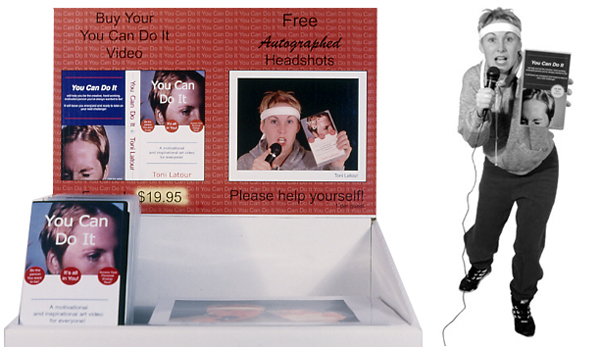The You Can Do It! project explores popular culture’s fascination with self-help guides and gurus. It investigates the business of self-help products, combining lampoon, kitsch, and sincerity.
It was first developed in 1999 as a video, with the artist delivering a 10-minute stream of consciousness monologue of positive messages. Satirizing the industry of motivation, it depicted Latour encouraging others while ultimately encouraging herself.
The project has since expanded to include performance work (an artist led motivational workshop with audience interaction), and several exhibitions and screenings.
In it’s most recent incantation at The Surrey Art Gallery (2004), it was redeveloped into a site-specific installation where gallery visitors could drop by and be inspired. The installation included two looped videos on a plasma screen, a life-sized cut out of the artist in her motivator persona, and a promotional stand with free autographed headshots and videos for sale. Inside The Surrey Art Gallery Tech Lab, the You Can Do It! video was projected. At the opening reception, Latour offered a free encore performance in the style of a motivational speaker. The audience participated in a range of activities including exercising, chanting and writing a note to the person beside them in a gesture of positivity. Watch You Can Do It! (1999)
The first plasma screen video was titled Smile. It depicts Latour in her motivator costume smiling constantly for 7 minutes, and as a result her face quivers and twitches uncontrollably. The last few seconds are slowed down in what she refers to as a We Are the Champions style final slow-mo sequence – her mouth finally relaxes, only to begin to smile again at the end. The piece speaks to the idea of continued public performance, and internal motivational desires. “It is an endurance piece that deconstructs a simple gesture, by sustaining the expression beyond its natural time. This awkward and multi-layered piece relays extremes between surface and depth — though one simple expression…In a society full of individuals obsessed with feeling good, SMILE looks at the dynamics of emotion. It forms a type of negotiation or compromise, to see between this dichotomy of pleasure and pain and find a sense of balance. Or at least reach a point where we can find and accept a balance without using Valium or Prozac along the way” (Colleen Heslin, ASPECT: The Chronicle of New Media). Watch Smile (2003)
The second plasma screen video, entitled for the camera, has the artist repeating the line “I’m on top again”. This high contrast black and white piece is reminiscent of the stylized marketing campaigns of the GAP. In it, Latour plays with the marketability of self, while maintaining references to self motivation. In a coy, self- consumed posture, she transforms the meaning of her words through simple repetition. Watch For the Camera Video (2003)





